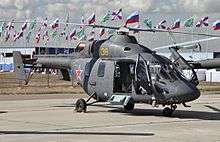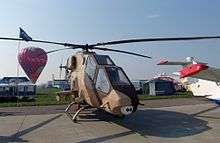Kazan Ansat
| Kazan Ansat | |
|---|---|
.jpg) | |
| A Kazan Ansat | |
| Role | Multipurpose utility helicopter |
| Manufacturer | Kazan Helicopters |
| Designer | Kazan Helicopters |
| First flight | August 17, 1999 |
| Introduction | August 28, 2013 |
| Status | In service |
| Primary user | Russian Air Force |
| Produced | 1998–present |
| Number built | 57 |
The Kazan Ansat is a Russian light, multipurpose helicopter manufactured by Kazan Helicopters.
Development
Kazan Helicopters in Kazan, Tatarstan, Russia has been one of the main Russian manufacturers of helicopters of the Mikhail Mil bureau design. In the 1990s management realized that there would be a need for light helicopters in Russia, as the fleet of standard Mi-2's was getting older, and the design itself became obsolete. The Mi-2 was the lightest helicopter in large-scale use in the former USSR, despite being larger than most light Western helicopters. At first Kazan Helicopters wanted to develop a helicopter based on the AS 350 Ecureuil in cooperation with Eurocopter, but it failed.
As a result, in 1993 Kazan Helicopters organized its own design bureau in order to create a new helicopter (the bureau was officially certified by the Russian authorities in January 1997). The helicopter was named Ansat (meaning light", "simple" or "easy" in the Tatar language).[1]
In 1998 the first prototype for ground static tests was completed. The second prototype (no. 02, then 902) first flew on August 17, 1999, but the first official flight was made on October 6, 1999. It was powered by two Pratt & Whitney Canada PW206 engines. Another prototype, with a longer and slimmer fuselage, and powered by two PW207K engines, flew on December 27, 2001 (no. 03, then 904). From 2002 it was undergoing the certification process. The third prototype introduced clam shell doors for the cabin opening upwards and downwards, instead of the sliding ones. It was offered as the Ansat-U military trainer variant with dual controls. As of 2005, apart from the fourth prototype, no further Ansat's had yet been built.
In September 2001[2] the Ansat-U won a contest for a trainer helicopter for the Russian Air Force. By 2010 four were in service with the Russian Air Force's Syzran Military Pilot Flying Training School. A further 20 are planned, to be powered by Ukrainian Motor Sich MS-500V engines replacing the Pratt & Whitney engines of the first four Ansats.[3] New light multi-purpose civilian helicopter "ANSAT" with hydromechanical control system of JSC "Kazan Helicopter Plant" has received type certification of Aviation Register of the Interstate Aviation Committee (IAC) August 28, 2013.[4] Type Certificate of IAC AR, allowing (freight) helicopters to begin commercial operation, was obtained in August 2013. In December 2014, IAC AR issued the approval of the main changes (addition to the type certificate), allowing for the transportation of the passengers on the commercial market. The emergence of medical options was the final step in creating a unified helicopter, certified for transport and medical works, transportation of people. Earlier, versions of these helicopters were used by the Ministry of Defense, Ministry of Emergency Situations, Ministry of Internal Affairs, FSB and other state structures of Russia.[5] Ansat light multi-purpose helicopter has been certified for operation under extremely cold and high temperatures in 2017-2018.[6]
_cockpit.jpg)
Today in the Russian military operation are more than 30 helicopters "ANSAT" in training modification "ANSAT-U".[7] May 22, 2015, Holding "Helicopters of Russia" within the VIII International Helicopter Industry Exhibition HeliRussia 2015 concluded the first two contracts for the supply of modernized light passenger helicopters "ANSAT".[8] VIP version was certified on December 30, 2015.[9] Ansat-UT's are to be fitted with wheeled landing gear, instead of skids. It is offered by Kazan Helicopters for the Russian and foreign markets, and for the Russian Air Force.
Design
The Ansat is of a classic construction. It takes a pilot and 10 passengers (one of them sits next to the pilot). The fuselage has a pair of doors in pilot's cab, and a pair of upwards and downwards opening side doors in transport compartment. After the seats have been removed, it can take 1000 kg of cargo inside. On external hook, it can take 1300 kg of load. It is powered with two PW207K turboshaft engines, which produce 630 shp each. It features a four-blade main rotor and two-blade tail rotor.
Operational history
In 2017 Russian Helicopters became the initial launch customer for the Ansat under civilian purposes. The Russian Government also placed an order for fifty units for the Air Force.[10]
During the Hydroaviasalon-2018 exhibition, subsidiaries of Rostec State Corporation — Russian Helicopters, National Service of Medical Aviation and Avia Capital Services LLC — signed a contract to supply 104 Ansat and 46 Mi-8AMT medically equipped helicopters.[11]
Variants

- Ansat
- Basic version, 2 prototypes built.
- Ansat-M
- Air ambulance for two stretchers.
- Ansat-O
- Flying laboratory for testing of avionic equipment for naval helicopters.
- Ansat-U
- Special military-training version with three-wheel chassis and double-winged cargo doors.
- Ansat-UM
- Military medevac for 4 stretchers.
- Ansat-1K
- Version certified only for cargo transport.
- Ansat-1M
- Version with hydro-mechanical control system KSU-A instead of the fly-by-wire control system.
Kazan Ansat derivatives

- Kazan Ansat-2RC
- Derived from the civilian version and equipped with a 12.7mm (0.5 inch) machine gun above the front skid support, as well as four hardpoints spread across two stub wings. The company has already displayed the helicopter carrying a mixture of rocket launcher tubes, bombs and anti-aircraft missiles.[12]
Operators
- Russian Air Force – 50 in service.[13]
- Ministry of Health – 6 in service + 12 on order as of 2017.[14]
- Russian Helicopters – 1 in service as of 2017.[10]
- State Transport Leasing Company – 12 on order, these helicopters will be equipped with medical modules.[15]
Specifications
Data from Jane's All The World's Aircraft 2003–2004,[2] Russian Helicopters[16]
General characteristics
- Crew: 1–2
- Capacity:
- 7–8 passengers
- 2 stretchers and 3 attendants
- Internally 1,234 kg (2,721 lb)
- Length: 13.76 (45.1 ft)
- Rotor diameter: 11.5 m (38 ft)
- Height: 3.4 m (11 ft)
- Disc area: 103.87 m² (1,118.0 sq ft)
- Empty weight: 1,900 kg (4,200 lb)
- Loaded weight: 3,000 kg (6,600 lb)
- Max. takeoff weight: 3,600 kg (7,900 lb)
- Powerplant: 2 × Pratt & Whitney Canada PW207K turboshaft, 630 HP (470 kW) each
Performance
- Never exceed speed: 285 km/h (177 mph; 154 kn)
- Maximum speed: 275 km/h (171 mph; 148 kn)
- Cruise speed: 220 km/h (140 mph; 120 kn)
- Range: 515 km (320 mi; 278 nmi) with main fuel tanks
- Endurance: 3 hr 20 min
- Service ceiling: 4,800 m (15,700 ft) operational, 2,500 m (8,200 ft) hover
- Rate of climb: 21.5 m/s (4,230 ft/min)
See also
Aircraft of comparable role, configuration and era
References
| Wikimedia Commons has media related to Kazan Ansat. |
- ↑ Mladenov 2016, pp. 79–80.
- 1 2 Jackson 2003, pp. 378–379.
- ↑ Mladenov 2010, p. 26.
- ↑ "Гражданский "Ансат" с ГМСУ получил сертификат АР МАК » Ресурс машиностроения. Машиностроение: новости машиностроения, статьи. Каталог: машиностроительный завод и предприятия". I-mash.ru. Retrieved 2017-06-23.
- ↑ "ЦАМТО / Новости / "Ансат" и Ка-226Т производства "Вертолетов России" вышли на российский рынок гражданской авиации". Armstrade.org. Retrieved 2017-06-23.
- ↑ http://rostec.ru/en/news/ansat-has-been-certified-for-operation-under-extreme-temperatures/
- ↑ "«Вертолеты России» и Минобороны России наметили перспективы взаимодействия в 2015 году". Kazanhelicopters.ru. Retrieved 2017-06-23.
- ↑ "ЦАМТО / Новости / "Вертолеты России" заключили первые контракты на поставку легких вертолетов "Ансат"". Armstrade.org. Retrieved 2017-06-23.
- ↑ "ЦАМТО / Новости / Вертолет "Ансат" сертифицирован в VIP версии". Armstrade.org. Retrieved 2017-06-23.
- 1 2 "В Подмосковье представили первый гражданский «Ансат»". helicopter.su. 28 October 2016. Retrieved 22 October 2017.
- ↑ http://www.airrecognition.com/index.php/archive-world-worldwide-news-air-force-aviation-aerospace-air-military-defence-industry/global-defense-security-news/global-news-2018/september/4507-russian-helicopters-lands-massive-order-for-152-medical-helicopters.html
- ↑ "Kazan Ansat-2RC – Kazan Helicopter Plant | Aviation Photo #0969245". Airliners.net. Retrieved 2017-06-23.
- ↑ "World Air Forces 2018". Flightglobal Insight. 2018. Retrieved 14 August 2018.
- ↑ "Новые медицинские вертолеты "Ансат"". bmpd.livejournal.com. 21 October 2017. Retrieved 22 October 2017.
- ↑ "ГТЛК подписала контракты на закупку еще 31 медицинского вертолета". bmpd.livejournal.com. 7 December 2017. Retrieved 12 December 2017.
- ↑ "Features: Ansat". Russianhelicopters.aero. Retrieved 2017-06-23.
Bibliography
- Jackson, Paul. Jane's All The World's Aircraft 2003–2004. Coulsdon, UK: Jane's Information Group, 2003. ISBN 0-7106-2537-5.
- Mladenov, Alexander. "Re-engined Ansat for Russia". Air International, November 2010, Vol 79 No 5. p. 26. ISSN 0306-5634.
- Mladenov, Alexander. "Ansat". Air International, February 2016, Vol 90, No. 2. pp. 78–82. ISSN 0306-5634